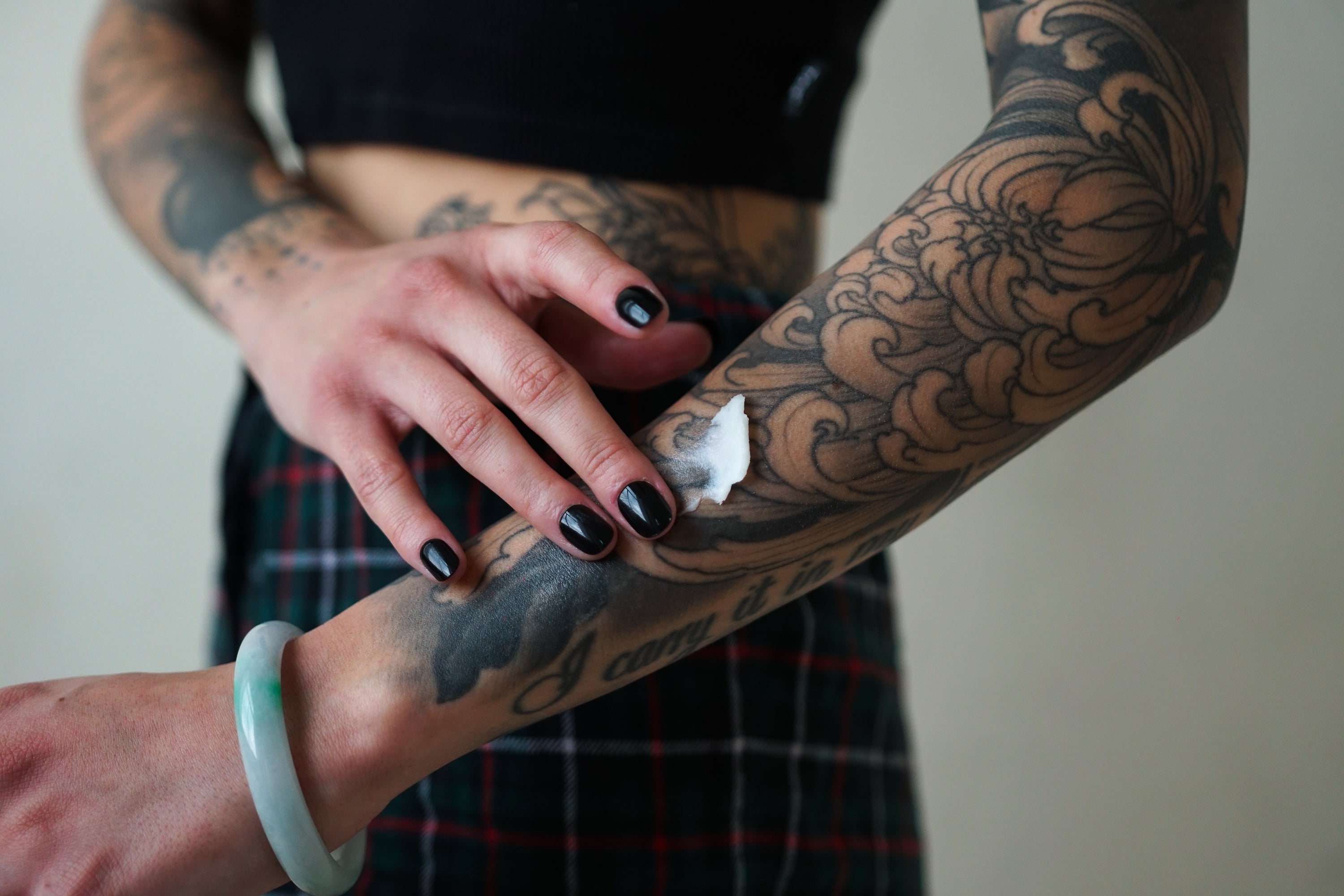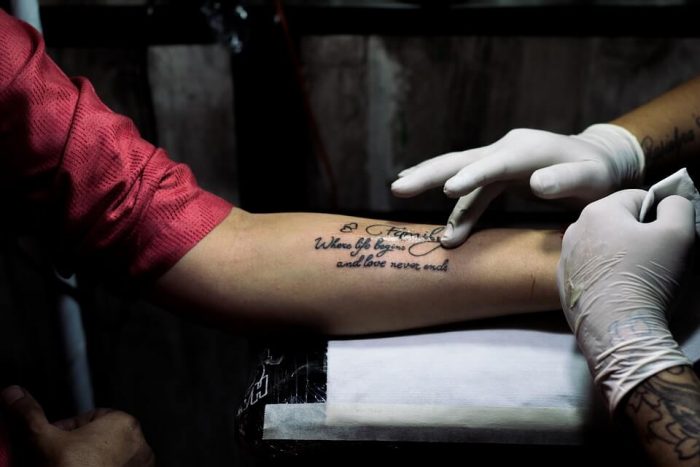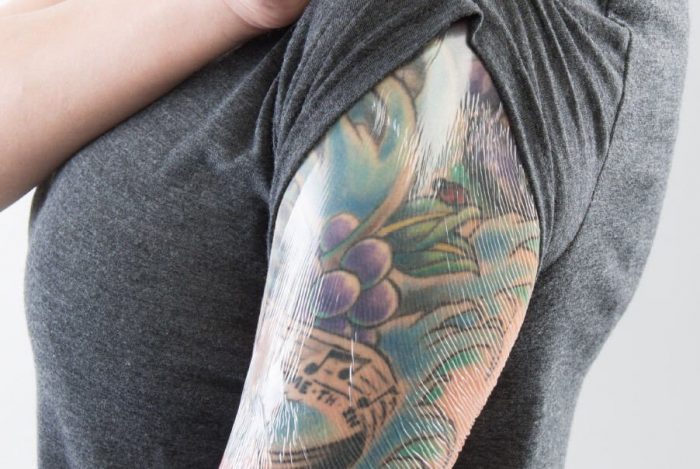How to Take Care of a Tattoo? Tattoo Aftercare During the First Days

How to take care of a Tattoo? Any new tattoo is an open wound that can lead to infection and leave scars on the skin if it doesn’t receive proper care.You need to thoroughly take care of a tattoo and clean it, so that it will heal fast.
Even the smallest tattoo should be cleaned appropriately. You should strictly follow the aftercare tattoo recommendations your tattoo artist gives you. Your tattoo artist (how to communicate with a tattoo artist properly) is interested in fast tattoo healing and does not want to see defects in their tattoo once it has healed.

Contents:
1. What to do during the first day after getting a tattoo2. How to apply a bandage on a tattoo3. How to remove a bandage from a tattoo4. Things to avoid during the process of tattoo healing

What to do during the first day after getting a tattoo?
Put simply, a new tattoo is a type of graze. This comparison is the best way to describe the sensations you feel after getting a tattoo. At first, you will have unpleasant feelings, but once you start applying a healing cream, these will reduce. Follow your tattoo artist’s recommendations and your tattoo will heal properly in no time.
These are the most common recommendations and care procedures from various tattoo artists.
Tattoo Aftercare – How to apply a bandage on a tattoo?
Tattoo artists have different opinions concerning polyethylene bandages for new tattoos. Some of them are totally against them because the skin doesn’t breathe under them, and they prevent the tattoo from healing. Polyethylene causes the greenhouse effect which creates a positive environment for bacterial growth. Others think that a disinfectant healing cream prevents bacterial growth under a bandage. On the other hand, if a tattoo is reliably covered and bacteria won’t be able to get in from the outside.
“I did tattoos in various salons and the healing procedures in each place were different. One tattoo artist forbade us to use polyethylene because he considered it an outdated bandage type, which prevented tattoo healing. We covered fresh tattoos with a bandage that you can buy in any drugstore, and fixed it with a plaster. Another tattoo artist would cover the tattoo with a polyethylene film. He advised people to clean the tattoo more often and to apply a cream. The tattoos in both of these cases healed without any problems.”
Some types of bandages cover tattoos for up to 24 hours. Usually, this is a breathable cotton bandage. Polyethylene or other synthetic bandages are removed from a tattoo earlier. If using polyethylene film, it should be changed more often.
The only type of bandage for certain tattoos (for example, a big tattoo on the back) is a polyethylene film one!
Tattoo Aftercare – How to remove a bandage from a tattoo?
1. Wash your hands with soap. You can also use chlorhexidine but this isn’t obligatory.
2. Remove the bandage or the polyethylene film from the tattoo carefully. At the beginning of the healing process, there is active regeneration in the skin, which can cause some ink to exude from the tattoo.
3. Clean the tattoo with water. The water should be a comfortable temperature, not too ʜᴏᴛ or too cold. Carefully remove any cream applied by the tattoo artist from the tattoo. Dry the tattoo with a paper towel or a clean cotton towel that doesn’t leave any fluff behind. Some artists recommend cleaning a tattoo with chlorhexidine after washing it with water. This will disinfect the tattoo without damaging the picture.
4. Apply a thin layer of a healing cream recommended by your tattoo artist. Panthenol, bepanthen, bepanthen plus are often recommended. Be careful with levomekol as in some cases it expels ink and the tattoo color can be less solid once it has healed.
5. Apply a bandage recommended by your artist. It can be polyethylene, a cotton bandage or a special plaster (in the case of small tattoos).
These procedures will need to be done several times. A scab will soon appear on a tattoo (just like a graze) and it is not advisable to pick it off. Your tattoo artist will specify the number of days you should apply a bandage, and the frequency of cleaning. They work closely with your skin and therefore they know the best way to take care of a tattoo.
“Don’t do things which are not recommended by your artist, don’t clean your tattoo more often or less frequently than he or she recommends.”

Things to avoid during the process of tattoo healing:
- Don’t drink ᴀʟᴄᴏʜᴏʟ. ᴀʟᴄᴏʜᴏʟ thins blood and prevents a tattoo from healing.
- Try not to scratch or touch your tattoo. When a scab appears, it will start to itch. If this is the case, use a healing cream recommended by your artist. This will hydrate the skin and reduce itching.
- Avoid uncomfortable clothes. Close-fitting synthetic clothes can damage your tattoo. Wear comfortable loose-fitting clothes.
- Don’t sunbathe just after getting tattooed. Ink can fade. Even tattoos which are completely healed need a protective cream while sunbathing.
- Avoid physical activity. Postpone visits to the gym and swimming pool until your tattoo has completely healed (at least 2-3 weeks).
“My coach is also a tattoo lover and he strictly prohibited me from working out until my tattoo was healed. I had to catch up with workouts once it had healed. It wasn’t easy, but if you rush this stage, it will only damage your tattoo.”
- Don’t take a bath. Even if the tattooed area isn’t submerged, warm water can raise pressure which intensifies blood and lymph discharge and can prevent the tattoo from healing.
- It is a really bad idea to remove the scab from your tattoo. This will disappear in its own time, without damaging the ink.
“I suffered from trying to hasten the healing process. I was trying to remove a scab and it began to bleed, and as a result, a new scab appeared. This slowed down the healing process and it led to a terrible-looking gap in one of the lines. I had to tattoo this area again to fill in the gap.”